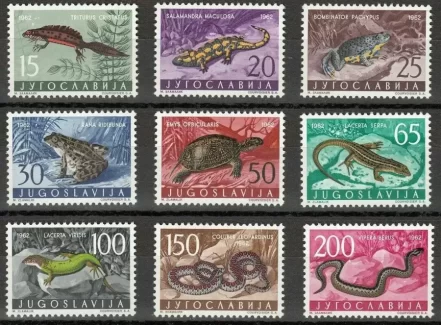Yugoslavia year 1962 Fauna Amphibians and Reptiles full set
Amphibians and reptiles are two distinct groups of vertebrate animals, both of which belong to the larger class of animals known as tetrapods, meaning they have four limbs or are descended from animals with four limbs. While they share some similarities, such as ectothermic (cold-blooded) metabolism and laying eggs, there are also significant differences between them.
Amphibians:
- Amphibians are characterized by their dual life cycle, spending the early stages of their lives in water (as larvae) and transitioning to a semi-aquatic or terrestrial lifestyle as adults.
- Their skin is typically permeable, allowing for gas exchange, but also making them susceptible to dehydration.
- Amphibians generally lay eggs in water, and most species undergo metamorphosis from aquatic larvae (such as tadpoles) to terrestrial adults.
- Examples of amphibians include frogs, toads, salamanders, and newts.
Reptiles:
- Reptiles are primarily terrestrial animals, although some species, such as sea turtles, spend significant portions of their lives in water.
- They have scaly skin, which helps to prevent water loss and provides protection from the environment.
- Reptiles lay amniotic eggs on land, protected by a shell that prevents desiccation and provides a suitable environment for embryonic development.
- Unlike amphibians, reptiles do not undergo metamorphosis, and their young resemble miniature versions of the adults.
- Examples of reptiles include snakes, lizards, turtles, crocodiles, and alligators.
Both amphibians and reptiles play important ecological roles within their respective ecosystems. Amphibians, for example, are often considered indicators of environmental health due to their sensitivity to changes in habitat quality and pollution. Reptiles contribute to ecosystem balance by controlling insect populations and serving as prey for larger predators.
While they have adapted to various habitats and environments worldwide, both amphibians and reptiles face numerous threats, including habitat loss, pollution, climate change, and disease. Conservation efforts aimed at protecting these animals and their habitats are crucial for maintaining biodiversity and ecosystem health.












Reviews
There are no reviews yet.